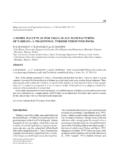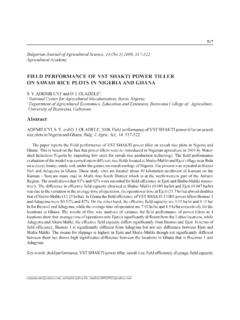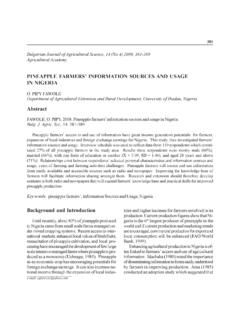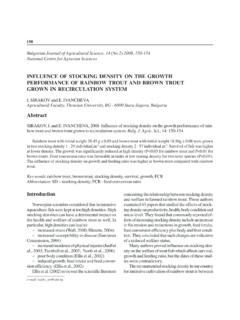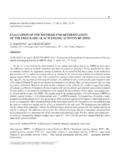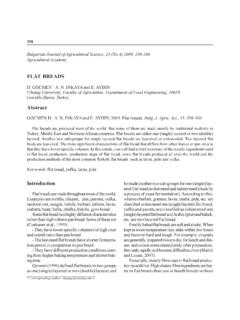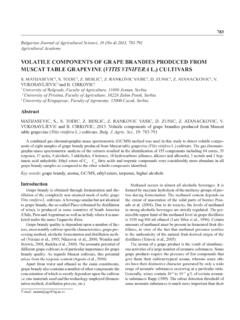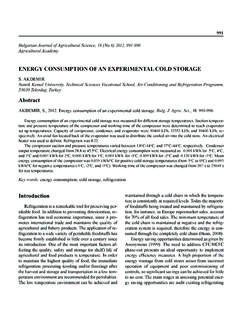Transcription of AGRICULTURAL LAND USE IN MALAYSIA: AN …
1 60 AGRICULTURAL land USE IN MALAYSIA: an historical overview and implications for FOOD SECURITY A. O. OLANIYI1, A. M. AbduLLAh1*, M. F. RAMLI1 and A. M. SOOd21 University Putra Malaysia, Department of Environmental Sciences, Faculty of Environmental Studies, 43400 Serdang, Darul Eshan, Selangor, Malaysia2 University Putra Malaysia, Department of Forest Production, Faculty of Forestry, 43400 Serdang, Darul Eshan, Selangor, MalaysiaAbstractOLANIYI, A. O., A. M. AbduLLAh, M. F. RAMLI and A. M. SOOd, 2013. AGRICULTURAL land use in Malaysia: an historical overview and implications for food security. Bulg. J. Agric. Sci., 19: 60-69A study is conducted to describe the historical overview of AGRICULTURAL land use in Malaysia with the aim of identifying the challenges of AGRICULTURAL land use in a dynamic economic system.
2 Economic policies were explained with major policies instruments. The effects of these policies on patterns of AGRICULTURAL land use in 1960 2005 were assessed. Findings identi-fied three broad economic eras in Malaysia: AGRICULTURAL (1960 - 1974); Industrial (1975 - 1999) and Urbanization eras (2000 - date). Macroeconomic policies that favored industrialization and urbanization had negative effects on AGRICULTURAL land use by competing with AGRICULTURAL sectors for production inputs such as labor and capital because the better conditions of service and higher returns per capital in the industrial sector led to the withdrawal of inputs from the AGRICULTURAL sectors.
3 Subsequent change in tastes due to increased per capita income resulted to a change in AGRICULTURAL land use in favor of highly rewarding and better-demanded crops (fruits and vegetables) thus causing AGRICULTURAL land use dynamics. Sustainable AGRICULTURAL land use in Malaysia, given scarce resource inputs (labor and capital) trade liberalization and globalization will depend on the abil-ity of the country to deepen her application of science and technology for automated AGRICULTURAL practices, diseases and pests control and high yielding varieties and suitable land administration policies for Malaysia to compete favorably with other major low cost producers.
4 Key words: AGRICULTURAL land use change, comparative costs advantage, change in taste, economic policies, drivers of land use changes, industrial sectors Bulgarian Journal of AGRICULTURAL Science, 19 (No 1) 2013, 60-69 AGRICULTURAL Academy* Corresponding author: IntroductionGovernment in most cases indicate the direction of the national economic growth through policies such as subsidies, trade liberalization and globalizations, infra-structures development, public expenditures and other monetary policies (Geist and Lambin, 2001). These gov-ernment policies have effects on AGRICULTURAL land use dynamics (Buchecker et al., 2003; Braimoh, 2009) im-mediately or in the long term (Lambin et al.)
5 , 2003). For instance, AGRICULTURAL land use in Malaysia is influenced by the implementation of policies (First to Third Malaysia Plan and the New Economic Policy [1965 1980]) that gave priority to AGRICULTURAL devel-opment as a means to economic growth (Rasiah, 1995; Abdullah and Hezri, 2008). However, AGRICULTURAL land use in country was later influenced by globalization. For instance, the boom in the global automobile and trans-port industry provided encouraging price and large mar-ket for the Malaysian natural rubber until the discovery of synthetic rubber, which brought about poor price of natural rubber and thus discourage further investment in rubber field expansion and lead to the conversion of rubber plantation to other uses (Sekhar, 2000).
6 Where- AGRICULTURAL land Use in Malaysia: an historical overview and implications for Food Security 61as, the favorable price enjoyed by oil palm produce in the global market (Lim, 1967 cited in Siwar et al., 2006) saw the conversions of former cocoa, coconut, rubber and paddy fields to oil palm plantation (Hill, 1982). Reardon et al. (1999) found macroeconomic policies to be major factors affecting farmers land -use decision-making. For instance, when macroeconomic policies are formulated at the national level in response to globaliza-tion or other economic forces, incentives are offered to farmers to cope with the effects of the policies, farmers act on the incentives by adjusting their resource alloca-tion at the farm level (Reardon et al.)
7 , 1999). Therefore, trade liberalization policies such as (World Trade Or-ganization [WTO] Common Effective Preferential Tar-iff (CEPT) Schemes of the ASEAN Free Trade Area [AFTA]) have influence AGRICULTURAL land use in Ma-laysia (Reardon et al., 1999). These policies positively influenced the Malaysian oil palm industry (Rasiah et al., 2000) but negatively affected the paddy subsector (MDoA, 2003). It had been documented that Malaysia, that was almost self sufficient in paddy production by 1976 had to recourse to rice importation on realization that other neighboring countries have comparative cost advantage over her in rice production (MDoA, 2003).Previous studies on the relationships between pol-icies and potential effects on AGRICULTURAL land use in Malaysia existed in discrete forms (Fee, 1985; Abdul-lah and Hezri, 2008) and are not suitable for general-izing for the entire country.
8 Study by (Wan, 1985) is outdated and therefore needs to be updated with recent data, whereas studies by APO, 2003 only examined the effects of land use on pollution of AGRICULTURAL resourc-es. Comprehensive studies of the implications of eco-nomic policies on AGRICULTURAL land use dynamics are kept at the confines of the government agencies and are not immediately available to the academic world. The scarcity of country - wide and updated literatures on this subject matter makes this study a worthwhile and relevant to the academic and political class who might need the outcome for decision-making. The objective of this study is to explain how fiscal policies have af-fected AGRICULTURAL land use in Malaysia and to make recommendation for a sustainable AGRICULTURAL land use in 1.
9 Location of MalaysiaSource: CIA, 2007120 0`0``E90 0`0``E90 0`0``E30 0`0``N30 0`0``S0 0`0``30 0`0``S30 0`0``N0 0`0``120 0`0``E150 0`0``E150 0`0``E62 A. O. Olaniyi, A. M. Abdullah, M. F. Ramli and A. M. SoodMaterial and MethodMalaysia is a tropical, South East Asian country located between latitudes 20 and 70 N and longitude 920 a n d 1120 E (Nieuwolt et al., 1982). Malaysia borders Thailand and Brunei in the north; Singapore and Indo-nesia in the south. It is divided into three main regions, Peninsular Malaysia, Sabah and Sarawak (Figure 1). Malaysian soils are acidic, highly weathered ultisols and oxisols (International Board for Soil Research and Man-agement - IBSRAM 1985) and of low pH ( - ); base saturation and nitrogen contents (Nieuwolt et al.)
10 , 1982). Malaysia has a land area of million ha with only about 31% of it being arable (Table 1). Agriculture is one of the main land use in Malaysia (Aminuddin et al., 1990) (Table 1 and Figure 2) and has played a ma-jor role in economic development of the country as a source of food, employment, export earner and raw ma-terials for agro based industries (Arshad, 2007) (Tables 2 and Figures 3, 4 and 5). More so, of the Malaysian total arable land , available record showed that over 70% is dominated by tree crops plantation (Wong, 2007) thus threatening sustainable food crop production in the country. More so, the development of agriculture from Table 1 land distribution and land use in Malaysia, %Region MalaysiaPeninsula MalaysiaSarawakSabahTotal land area, million ha area suitable for agriculture, million area suitable for agriculture, % area unsuitable for agriculture, % : Aminuddin et al.
